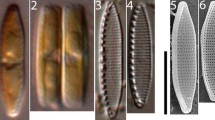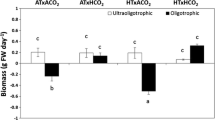Abstract
Some of the mechanisms involved in inorganic carbon (Ci) acquisition by tropical seagrasses from the western Indian Ocean were described by Björk et al. (Mar Biol 129:363–366, 1997). However, since then, it has been found that an additional, buffer-sensitive, system of Ci utilisation may operate in some temperate seagrasses (Hellblom et al. in Aquat Bot 69:55–62, 2001, Hellblom and Axelsson in Photos Res 77:173–191, 2003); this buffer sensitivity indicates a mechanism in which electrogenic H+ extrusion may form acidic diffusion boundary layers, in which either HCO −3 –H+ is co-transported into the cells, or where HCO −3 is converted to CO2 (as catalysed by carbonic anhydrase) prior to uptake of the latter Ci form. Because a buffer was used in the 1997 study, we found it important to reinvestigate those same eight species, taking into account the direct effect of buffers on this potential mode of Ci acquisition in these plants. In doing so, it was found that all seagrass species investigated except Cymodocea serrulata were sensitive to 50 mM TRIS buffer of the same pH as the natural seawater in which they grew (pH 8.0). Especially sensitive were Halophila ovalis, Halodule wrightii and Cymodocea rotundata, which grow high up in the intertidal zone (only ca. 50–65% of the net photosynthetic activity remained after the buffer additions), followed by the submerged Enhalus acoroides and Syringodium isoetifolium (ca. 75% activity remaining), while Thalassia hemprichii and Thalassodendron ciliatum, which grow in-between the two zones, were less sensitive to buffer additions (ca. 80–85% activity remaining). In addition to buffer sensitivity, all species were also sensitive to acetazolamide (AZ, an inhibitor of extracellular carbonic anhydrase activity) such that ca. 45–80% (but 90% for H. ovalis) of the net photosynthetic activity remained after adding this inhibitor. Raising the pH to 8.8 (in the presence of AZ) drastically reduced net photosynthetic rates (0–14% remaining in all species); it is assumed that this reduction in rates was due to the decreased CO2 concentration at the higher pH. These results indicate that part of the 1997 results for the same species were due to a buffer effect on net photosynthesis. Based on the present results, it is concluded that (1) photosynthetic Ci acquisition in six of the eight investigated species is based on carbonic anhydrase catalysed HCO −3 to CO2 conversions within an acidified diffusion boundary layer, (2) C. serrulata appears to support its photosynthesis by extracellular carbonic anhydrase catalysed CO2 formation from HCO −3 without the need for acidic zones, (3) H. ovalis features a system in which H+ extrusion may be followed by HCO −3 –H+ co-transport into the cells, and (4) direct, non-H+-mediated, uptake of HCO −3 is improbable for any of the species.


Similar content being viewed by others
References
Beer S, Björk M (2000) A comparison of photosynthetic rates measured by pulse amplitude modulated (PAM) fluorometry and O2 evolution in two tropical seagrasses. Aquat Bot 66:69–76
Beer S, Rehnberg J (1997) The acquisition of inorganic carbon by the seagrass Zostera marina. Aquat Bot 56:277–283
Beer S, Björk M, Hellblom F, Axelsson L (2002) Inorganic carbon utilization in marine angiosperms (seagrasses). Funct Plant Biol 29: 349–354
Björk M, Weil A, Semesi S, Beer S (1997) Photosynthetic utilization of inorganic carbon by seagrasses from Zanzibar, East Africa. Mar Biol 129:363–366
Dobrovinskaya OR, Muniz J, Pottosin II (1999) Asymmetric block of the plant vacuolar Ca2+-permeable channel by organic cations. Eur Biophys J 28:552–563
Gordon-Weeks R, Korenkov VD, Steele SH, Leigh RA (1997) Tris is a competitive inhibitor of K= activation of the vacuolar H+ -pumping pyrophosphatase. Plant Physiol 114:901–905
Hellblom F, Axelsson L (2003) External HCO −3 dehydration maintained by acid zones in the plasma membrane is an important component of the photosynthetic carbon uptake in Ruppia cirrhosa. Photos Res 77:173–191
Hellblom F, Beer S, Björk M, Axelsson L (2001) A buffer sensitive inorganic carbon utilization system in Zostera marina. Aquat Bot 69:55–62
Lucas WJ, Keifer DW, Sanders D (1983) Bicarbonate transport in Chara corallina: Evidence for cotransport of HCO −3 with H+. J Membr Biol 73:263–274
Maren TH (1984) The general physiology of reactions catalyzed by carbonic anhydrase and their inhibition by sulphonamides. Ann N Y Acad Sci 429:568–579
Moroney JV, Husic HD, Tolbert NE (1985) Effects of carbonic anhydrase inhibitors on inorganic carbon accumulation by Chlamydomonas reinhardtii. Plant Physiol 79:177–183
Price GD, Badger MR (1985) Photosynthetic utilization of bicarbonate in Chara corallina. Aus J Plant Physiol 12:257–267
Schwarz AM, Björk M, Buluda T, Mtolera M, Beer S (2000) Photosynthetic utilization of carbon and light by two tropical seagrass species as measured in situ. Mar Biol 137:755–761
Acknowledgements
We thank Mia Bengtson for excellent assistance in both field collections and laboratory work. We also thank the personnel of IMS, Zanzibar, for their assistance and for the use of their facilities. Financial support was provided by Sida/SAREC.
Author information
Authors and Affiliations
Corresponding author
Additional information
Communicated by O. Kinne, Oldendorf/Luhe
Rights and permissions
About this article
Cite this article
Uku, J., Beer, S. & Björk, M. Buffer sensitivity of photosynthetic carbon utilisation in eight tropical seagrasses. Marine Biology 147, 1085–1090 (2005). https://doi.org/10.1007/s00227-005-0019-0
Received:
Accepted:
Published:
Issue Date:
DOI: https://doi.org/10.1007/s00227-005-0019-0




